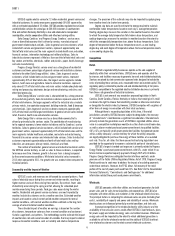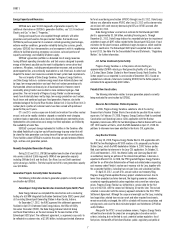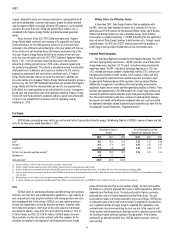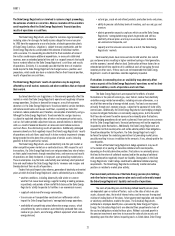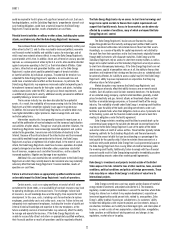Duke Energy 2012 Annual Report Download - page 35
Download and view the complete annual report
Please find page 35 of the 2012 Duke Energy annual report below. You can navigate through the pages in the report by either clicking on the pages listed below, or by using the keyword search tool below to find specific information within the annual report.
PART I
15
of commodities and services, along with the quality and reliability of services
provided, drive competition in the energy marketing business. Commercial
Power’s main competitors include other nonregulated generators in the
Midwestern U.S., wholesale power providers, coal and natural gas suppliers,
and renewable energy.
Fuel Supply
Commercial Power relies on coal and natural gas for its generation of
electric energy.
Coal.
Commercial Power meets its coal demand through a portfolio of purchase
supply contracts and spot agreements. Large amounts of coal are purchased
under supply contracts with mining operators who mine both underground
and at the surface. Commercial Power uses spot-market purchases to meet
coal requirements not met by supply contracts. Expiration dates for its supply
contracts, which have various price adjustment provisions and market
re-openers, range through 2018. Commercial Power expects to renew these
contracts or enter into similar contracts with other suppliers for the quantities
and quality of coal required as existing contracts expire, though prices will
fl uctuate over time as coal markets change. The majority of Commercial Power’s
coal is sourced from mines in the Northern Appalachian and Illinois basins.
Commercial Power has an adequate supply of coal to fuel its projected 2013
operations. The majority of Commercial Power’s coal-fi red generation is equipped
with fl ue gas desulfurization equipment. As a result, Commercial Power is able to
satisfy the current emission limitations for SO2 for existing facilities.
Gas.
Commercial Power is responsible for the purchase and the subsequent
delivery of natural gas to its gas turbine generators. In general Commercial
Power hedges its natural gas requirements using fi nancial contracts. Physical
gas is purchased in the spot market to meet generation needs.
INTERNATIONAL ENERGY
International Energy principally operates and manages power generation
facilities and engages in sales and marketing of electric power, natural gas, and
natural gas liquids outside the U.S. It conducts operations through DEI and its
affi liates and its activities principally target power generation in Latin America.
Additionally, International Energy owns a 25% interest in National Methanol
Company (NMC), a large regional producer of methanol and methyl tertiary butyl
ether (MTBE) located in Saudi Arabia. The investment in NMC is accounted for
under the equity method of accounting. In the fi rst quarter of 2012, Duke Energy
completed the sale of International Energy’s indirect 25% ownership interest in
Attiki Gas Supply, S.A (Attiki), a Greek corporation, to an existing equity owner
in a series of transactions that resulted in the full discharge of the related debt
obligation. See Note 13 to the Consolidated Financial Statements, “Investments
in Unconsolidated Affi liates” for additional information. In 2012, International
Energy acquired a 240 MW thermal plant in southern Chile. In addition,
International acquired Iberoamericana de Energía Ibener S.A., which owns and
operates a 140 MW hydro complex. See Note 2 to the Consolidated Financial
Statements, “Acquisitions and Dispositions of Businesses and Sales of Other
Assets,” for additional information.
International Energy’s customers include retail distributors, electric
utilities, independent power producers, marketers and industrial/commercial
companies. International Energy’s current strategy is focused on optimizing the
value of its current Latin American portfolio and expanding the portfolio through
investment in generation opportunities in Latin America.
International Energy owns, operates or has substantial interests in
approximately 4,900 gross MW of generation facilities. For information on International
Energy’s generation facilities, see “International Energy” in Item 2, “Properties.”
Competition and Regulation
International Energy’s sales and marketing of electric power and natural
gas competes directly with other generators and marketers serving its market
areas. Competitors are country and region-specifi c but include government-
owned electric generating companies, local distribution companies with
self-generation capability and other privately owned electric generating and
marketing companies. The principal elements of competition are price and
availability, terms of service, fl exibility and reliability of service.
A high percentage of International Energy’s portfolio consists of baseload
hydroelectric generation facilities which compete with other forms of electric
generation available to International Energy’s customers and end-users,
including natural gas and fuel oils. Economic activity, conservation, legislation,
governmental regulations, weather, additional generation capacities and other
factors affect the supply and demand for electricity in the regions served by
International Energy.
Recent legislation in Brazil allowed the renewal of certain concessions
that were granted prior to 1995 and due to expire in 2015 to 2017, if, among
other things, the concession holders dedicated their generation capacity to the
regulated market. International Energy’s concessions, which were granted after
1995, were not affected by this legislation. The change in market prices, if any,
from this legislation is not expected to have a signifi cant impact on International
Energy’s earnings and cash fl ows because its generation capacity is highly
contracted through 2016.
International Energy’s operations are subject to both country-specifi c and
international laws and regulations. (See “Environmental Matters” in this section.)
OTHER
The remainder of Duke Energy’s operations is presented as Other. While
it is not an operating segment, Other primarily includes unallocated corporate
interest expense, certain unallocated corporate costs, Bison Insurance Company
Limited (Bison), Duke Energy’s wholly owned, captive insurance subsidiary,
contributions to the Duke Energy Foundation, Duke Energy’s effective 50%
interest in DukeNet Communications, LLC (DukeNet) and related telecom
businesses, and Duke Energy’s effective 60% interest in Duke Energy Trading
and Marketing, LLC (DETM), which management is currently in the process of
winding down.
Bison’s principal activities as a captive insurance entity include the
indemnifi cation of various business risks and losses, such as property, business
interruption, workers’ compensation and general liability of subsidiaries and
affi liates of Duke Energy. DukeNet develops, owns and operates a fi ber optic
communications network, primarily in the southeast U.S., serving wireless, local
and long-distance communications companies, Internet service providers and
other businesses and organizations.
Regulation
Certain entities within Other are subject to the jurisdiction of state and
local agencies.
GEOGRAPHIC REGIONS
For a discussion of Duke Energy’s foreign operations see “Management’s
Discussion and Analysis of Results of Operations” and Note 3 to the
Consolidated Financial Statements, “Business Segments.”
EMPLOYEES
On December 31, 2012, Duke Energy had 27,885 employees. A total of
5,784 operating and maintenance employees were represented by unions.



